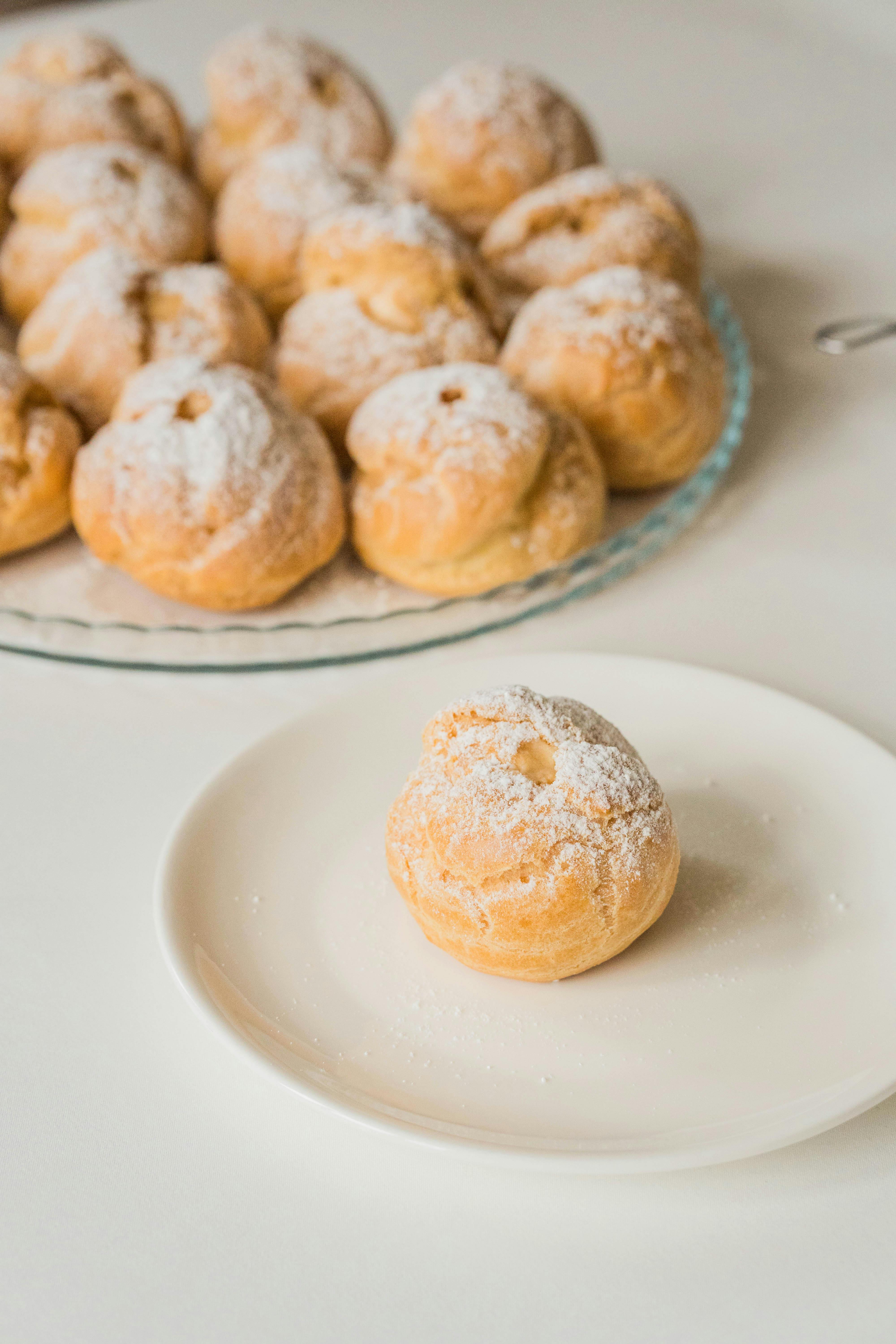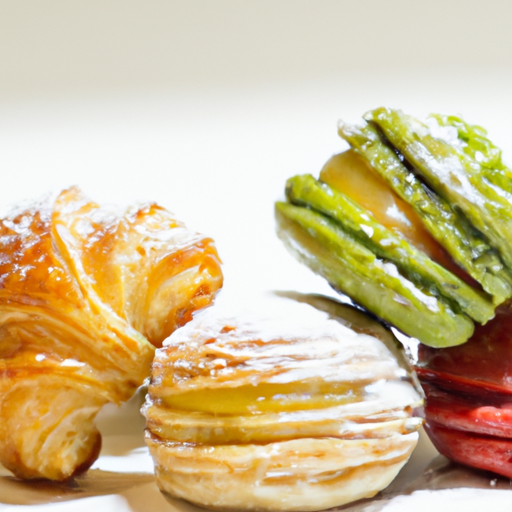Indulge your senses in the mouthwatering world of French patisserie, where each delicate dessert tantalizes both the eyes and the taste buds. In this article, Tastepan.com takes you on a delectable journey through the rich heritage of French pastry craftsmanship. Discover the artistry behind intricate pastries, such as the flaky croissants, airy macarons, and luscious tarts. With a blend of centuries-old traditions and innovative techniques, the French patisserie offers a truly unique and unforgettable culinary experience. Prepare to be enchanted by the sweet symphony of flavors and textures that await you in this world of delectable desserts.

History of French Patisserie
The art of French patisserie has a long and rich history that dates back centuries. The origins of French patisserie can be traced back to the Middle Ages, when baking became increasingly popular in France. During this time, bakers began experimenting with different ingredients and techniques, laying the foundation for what would eventually become the art of French patisserie as we know it today.
Origins of French Patisserie
French patisserie draws its influences from various cultures and culinary traditions. The Middle East, for instance, played a significant role in introducing the French to the wonders of pastry-making. The Crusaders returning from the Holy Land brought with them new and exotic ingredients like almonds, honey, and spices, which were then incorporated into French baking.
Evolution of Patisserie in France
Over the centuries, patisserie in France continued to evolve and improve. The French became renowned for their mastery of pastry techniques and their attention to detail. In the 17th and 18th centuries, the art of French patisserie reached new heights with the establishment of guilds and training schools dedicated to the craft. This period saw the creation of iconic French pastries and desserts that are still enjoyed today.

Influential Figures in French Patisserie
Several influential figures have played a pivotal role in shaping the world of French patisserie. One such figure is Marie-Antoine Carême, often referred to as the “King of Chefs and the Chef of Kings.” Carême revolutionized French patisserie with his grand and elaborate creations, introducing intricate designs and architectural elements to desserts.
Another renowned name in the world of French patisserie is August Escoffier, a legendary chef who is considered the father of modern French cuisine. Escoffier’s emphasis on precision and technique greatly influenced the art of patisserie and elevated it to new heights.
Characteristics of French Patisserie
French patisserie is known for its distinct characteristics that set it apart from other culinary traditions.
Attention to detail
One of the defining characteristics of French patisserie is the meticulous attention to detail that goes into creating each pastry. From the delicate piping of buttercream to the precise layering of flavors and textures, every element of a French pastry is meticulously crafted with precision and care.
Use of high-quality ingredients
Another hallmark of French patisserie is the use of high-quality ingredients. French pastry chefs emphasize the importance of sourcing the finest ingredients, such as premium chocolates, fresh fruits, and fragrant vanilla, to create desserts that are not only visually stunning but also bursting with flavor.
Focus on technique and precision
French patisserie places a strong emphasis on technique and precision. From the art of tempering chocolate to the skillful folding of meringue, each step in the process is executed with utmost care to ensure the perfect balance of flavors and textures.
Famous French Patisseries
France is home to numerous famous patisseries that have garnered international recognition for their exquisite creations. Here are a few of the most renowned:
Ladurée
Ladurée is perhaps one of the most iconic names in the world of French patisserie. Founded in 1862, this legendary Parisian patisserie is famous for its delectable macarons, which come in a wide array of flavors and boast a delicate, crisp exterior and a luscious, creamy filling.
Pierre Hermé
Pierre Hermé is known as the “Picasso of Pastry” for his innovative and artistic approach to patisserie. His signature creations feature bold and unexpected flavor combinations, such as rose and lychee or olive oil and vanilla, pushing the boundaries of traditional French patisserie.
Fauchon
Founded in 1886, Fauchon is a luxury patisserie and delicatessen that has become synonymous with elegance and refinement. Known for its opulent displays of pastries and desserts, Fauchon offers a wide range of decadent treats, from intricately crafted cakes to delicate éclairs and tarts.

Classic French Desserts
French patisserie is renowned for its classic desserts that have become staples of French culinary culture. Here are a few of the most beloved and iconic French desserts:
Macarons
Macarons are delicate meringue-based cookies sandwiched together with a flavorful filling. These colorful and dainty treats come in a multitude of flavors, from traditional options like pistachio and raspberry to more adventurous combinations like salted caramel and lavender.
Croissants
When it comes to breakfast pastries, few can rival the buttery and flaky perfection of a classic French croissant. With its distinct crescent shape and layers of crisp, golden pastry, the croissant is a true work of art.
Eclairs
Eclairs are long, slender pastries filled with rich custard or cream and topped with glossy chocolate icing. These elegant treats are as delicious as they are visually appealing, with their shiny glaze and piped decorations.
Regional Specialties
In addition to its classic desserts, French patisserie is also celebrated for its regional specialties that showcase the diversity and creativity of French cuisine. Here are a few examples:
Tarte Tatin
Originating from the region of Sologne, the Tarte Tatin is a caramelized upside-down apple tart. The apples are cooked in butter and sugar until caramelized, then covered with a layer of pastry and baked until golden and bubbling. The result is a sweet and sticky delight that is best enjoyed warm with a scoop of vanilla ice cream.
Paris-Brest
Created in 1891 to commemorate the Paris-Brest bicycle race, this circular-shaped pastry is made from choux pastry and filled with praline-flavored cream. Its unique shape represents a bicycle wheel, and it continues to be a popular dessert in France.
Cannele
Hailing from the Bordeaux region, the cannele is a small, caramelized cake with a custard-like interior and a slightly crispy exterior. Traditionally flavored with rum and vanilla, these dainty treats have a rich and indulgent flavor that is perfect for a sweet afternoon treat.
Savoury Patisserie
While French patisserie is often associated with sweet delights, savory pastries also hold a special place in the culinary landscape of France. Here are a few examples:
Quiche Lorraine
Quiche Lorraine is a classic French savory tart that features a rich filling of eggs, cream, cheese, and lardons of bacon. With its buttery pastry crust and flavorful combination of ingredients, the Quiche Lorraine is a staple of French cuisine and is served both hot or cold.
Gougères
Gougères are light and airy cheese puffs made from choux pastry dough mixed with grated cheese. These bite-sized morsels are often served as appetizers or as a snack alongside a glass of wine.
Pissaladière
Originating from the region of Nice, the Pissaladière is a savory tart topped with caramelized onions, olives, and anchovies. It is similar to a pizza but with distinct Mediterranean flavors.
Patisserie Techniques
French patisserie is as much about technique as it is about flavors and ingredients. Here are a few key techniques that are essential to mastering the art of French patisserie:
Pâte à Choux
Pâte à Choux is a versatile pastry dough that is used as a base for a variety of French pastries, such as éclairs and profiteroles. It is made by cooking together water, butter, flour, and eggs until a smooth and elastic dough is formed.
Meringue
Meringue is a light and airy mixture of egg whites and sugar that is often used as a topping or in fillings for French patisserie. There are three main types of meringue: French meringue, Italian meringue, and Swiss meringue, each with its own unique characteristics and uses.
Ganache
Ganache is a rich and creamy mixture of chocolate and cream that is used as a filling or frosting for many French pastries. It can be flavored with various ingredients, such as fruit purees, liqueurs, or spices, to create different variations of ganache.
Famous French Patisserie Chefs
French patisserie has produced some of the world’s most talented and innovative pastry chefs. Here are a few names that have made a significant impact on the world of French patisserie:
Christophe Michalak
Christophe Michalak is a renowned pastry chef and winner of the prestigious World Pastry Cup. His creations are known for their bold flavors and striking presentations, showcasing his avant-garde approach to French patisserie.
Cédric Grolet
Cédric Grolet is widely regarded as one of the most talented pastry chefs of his generation. His stunning fruit sculptures and innovative pastry designs have earned him international acclaim and a dedicated following.
Dominique Ansel
Dominique Ansel is perhaps best known for his creation of the Cronut, a croissant-doughnut hybrid that took the pastry world by storm. His innovative and whimsical approach to patisserie has earned him numerous awards and accolades.
Patisserie Trends
French patisserie is a dynamic and ever-evolving field, constantly pushing the boundaries of flavor, presentation, and technique. Here are a few trends that are shaping the world of French patisserie:
Innovation in flavors
In recent years, pastry chefs have been experimenting with unique and unexpected flavor combinations to create new and exciting desserts. From savory ingredients like olive oil and sea salt to unconventional pairings of fruits, herbs, and spices, the possibilities for flavor innovation in French patisserie are endless.
Artistic presentations
Aesthetics play a crucial role in French patisserie, and pastry chefs are increasingly focusing on creating visually stunning desserts that are as much works of art as they are culinary creations. Elaborate sugar decorations, intricate chocolate sculptures, and meticulous plating techniques are just some of the ways that pastry chefs are pushing the boundaries of presentation.
Health-conscious options
In response to the growing demand for healthier alternatives, pastry chefs are now developing patisserie options that cater to dietary restrictions and preferences. These include gluten-free pastries, sugar-free desserts, and vegan-friendly creations, showcasing the adaptability and versatility of French patisserie.
The French Patisserie Experience
A visit to a French patisserie is not just about indulging in delectable treats; it is a complete sensory experience that immerses you in the rich traditions and artistry of French patisserie.
Visiting a French Patisserie
When you step into a French patisserie, you are greeted by a tantalizing display of colorful pastries and desserts, meticulously arranged with precision and care. The intoxicating aromas of freshly baked bread and buttery croissants fill the air, luring you deeper into the world of patisserie.
Tasting and appreciation
Choosing which pastries to try can be a delightful challenge, as each one is a masterpiece in its own right. From the first bite, you are transported to a world of flavors and textures, each one more exquisite than the last. The subtleties of flavor, the delicate balance of sweetness, and the harmonious marriage of ingredients all come together to create a truly unforgettable taste experience.
French Patisserie traditions
French patisserie is deeply rooted in tradition, and many of the pastry recipes and techniques have been passed down through generations. From the precise measurements to the careful execution of each step, French patisserie is a celebration of craftsmanship and heritage.
In conclusion, French patisserie is a testament to the artistry and dedication of pastry chefs who have devoted their lives to creating exquisite desserts. From the origins in the Middle Ages to the present-day trends and innovations, French patisserie continues to captivate and delight with its attention to detail, use of high-quality ingredients, and focus on technique. So the next time you find yourself in a French patisserie, take a moment to savor the experience and appreciate the centuries of tradition and expertise that have gone into creating these delicate and delectable desserts.

